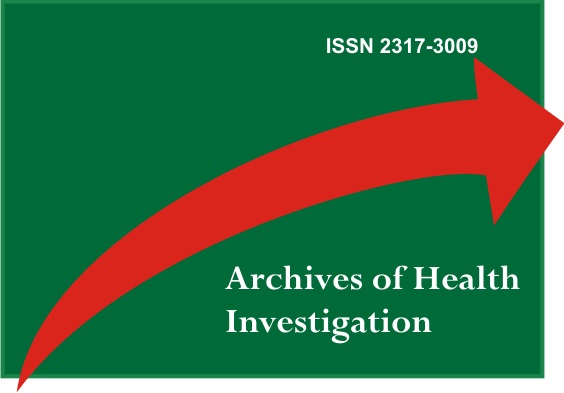Disfunção craniocervicomandibular com alteração do VIII par craniano em distrófico muscular: relato de caso
DOI:
https://doi.org/10.21270/archi.v10i5.4989Palavras-chave:
Cervicalgia, Distrofia Muscular de Duchenne, Dor Facial, Modalidades de FisioterapiaResumo
A disfunção craniocervicomandibular é uma condição comum, acredita-se que dois terços da população sofrerão dor cervical em algum momento da vida. Caracterizada por dor cervical; limitação da amplitude dos movimentos da região; ruídos articulares e tensão dos músculos da região cervical. Anatomicamente, a região cervical é a base e o suporte das estruturas da cabeça e pescoço, e por causa de sua proximidade e inervações comuns, as desordens da coluna cervical podem se manifestar com dores na região orofacial. Quando essa disfunção acomete uma pessoa com quadro distrófico muscular grave, tende a ter uma severidade muito maior. Este trabalho tem como objetivo avaliar a disfunção craniocervicomandibular em paciente portador de distrofia muscular compatível com Duchenne. Paciente 22 anos, gênero masculino compareceu a Policlínica Odontológica da Universidade do Estado do Amazonas, na clínica de Estomatologia queixando-se de incomodo na mandíbula, com ruído e dor. O mesmo relatou sentir constantes dores de cabeça, plenitude auricular e vertigem. Em seguida aos exames clínicos, avaliação das desordens temporomandibular e avaliação muscular, evidenciou-se o diagnóstico de Disfunção Craniocervicomandibular com Vestibulococleopatia. Deu-se início ao tratamento associada a fisioterapia a fim de condicionar um ambiente para o uso de placa miorrelaxante. Descritores: Cervicalgia; Distrofia Muscular de Duchenne; Dor Facial; Modalidades de Fisioterapia.
Downloads
Referências
Armijo-Olivo S, Rappoport K, Fuentes J, Gadotti IC, Major PW, Warren S, Thie NM, Magee DJ. Head and cervical posture in patients with temporomandibular disorders. J Orofac Pain. 2011;25(3):199-209.
Moraes FM, Fernandes RSC, Acosta EM. Distrofia Muscular de Duchenne: relato de caso. Rev-Cient-FMC. 2011; 6(2):11-15.
Mokri B, Engel AG. Duchenne dystrophy: electron microscopic findings pointing to a basic or early abnormality in the plasma membrane of the muscle fibre. Neurology. 1975;25(12):111-20.
Schmidt KC, Briesemeister M, Ries LGK. Changes in Mandibular and Cervical Motor Control of Children With Cerebral Palsy. Rev CEFAC. 2014;16(1):228-35.
Moreira AB, Morete M, Cordon F, Malezan WR. Disfunção Temporomandibular e dor Cervical: Comorbidades? Rev Aten Saúde. 2016;14(48):94-8.
Bigaton DR, Silvério KCA, Berni KCS, Distefano G, Forti F, Guirro RRJ. Postura craniocervical em mulheres disfônicas. Rev Soc Bras Fonoaudiol. 2010;15(3):329-34.
Martins BLA, Braga DRLM, Cabral LN. Disfunção massetérica e sialoadenite de refluxo: relato de caso. Arch Health Invest. 2019;8(1):43-7.
Godinho GV, Cabral LN. Disfunção craniocervicomandibular e alterações vestibulococleares: revisão de literatura. Arch Health Invest. 2019;8(8):405-12.
Gama BF, Barros FAM, Cardoso MBSC, Soares MA. Efeito da laserterapia baixa potência em pacientes com disfunção crânio cérvico-mandibular miogênica – análise através da biofotogrametria da biofotogrametria – estudo duplo cego. Persp Online. 2015;17(5):36-46.
Souza I, Oliveira R, Jacques H, Barradas N, Luzes R. A Relação de Coluna Cervical Com a Disfunção Temporomandibular e Seus Principais Sinais e Sintomas. Alumni UNIABEU. 2017;5(9):4-9.
Halmova K, Holly D, Stanko P. The influence of cranio-cervical rehabilitation in patients with myofascial temporomandibular pain disorders. Bratisl Lek Listy. 2017;118(11):710-13.
Silva F, Queiroz A, Serrano K. Alteraciones posturales y su repercusión en el sistema estomatognatico. Acta odontol venez. 2008;46(4):517-22.
Fernandes Neto AJ, Barbosa GA. Placas oclusais. Uberlândia: Universidade Federal de Uberlândia (UFU). 2005. 19 p.
Cruz L, Tegtmeier C, Consiglio M, Barrionuevo L, Correa K. Características clínicas orales en pacientes con distrofia muscular de Duchenne. Estudio descriptivo. Rehabil Integral 2018;13 (2):59-65.
Silva MM, Santos E, Sardelich PL. Distrofia Muscular de Duchenne: repercussões pós treinamento muscular respiratório relato de caso. RUEP. 2016;13(32):84-91.


